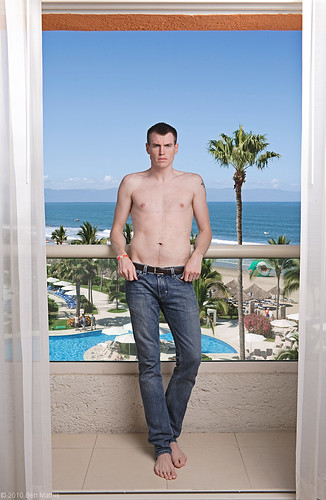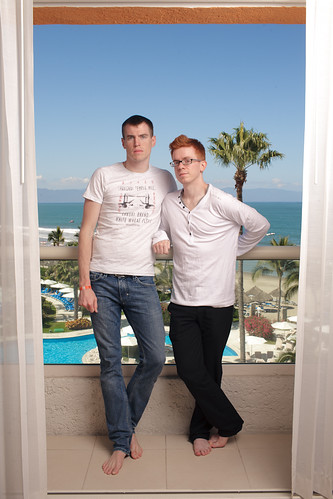
Settings: Background is properly exposed, flash into 1.5 meter softlighter II to camera right, with the light meter at face level powered to expose properly.
Agust and I went to Puerto Vallarta, Mexico last month. I actually lugged all of my studio lights down there for a photoshoot that didn't really pan out, but I went in knowing that might be the case. I made sure to use them anyway. The above photo used just the 1.5 meter softlighter. One problem is that the outside and inside are such different light types, the outside being harsh sunlight, and me being lit softly, that it looks composited or cut out. The fact they are even in brightness and focus is also contributing. This was intentional, as I wanted the outside to be clear and well lit to show just how nice the hotel and our balcony view was. In addition, it was unavoidable without neutral density filters. to properly expose the outdoors while staying under my sync speed (1/160), I had to go to f/11. This means that foreground and background on a 35mm lens (what I used) would be sure to be both in focus, even with the extreme distance from subject to distant background. If I did want a blurry background, a neutral density filter over the lens would let me increase the aperture. This is also a reason I'm glad I have the power of the Quadra, as I needed about 3-4 hotshoe flashes worth of power to equalize subject and background.
One thing I could have done, and did do for a later shot, is add a rim light. By adding a hard rim light, it reads visually as the sun coming onto the subject, which unifies the lighting, making for a less composited look.
Settings: Background is overexposed by half stop, flash into 1.5 meter softlighter II to camera right, with the light meter at face level powered to expose properly. 2nd flash through reflector with 20 degree grid behind subject to camera left, also properly exposed.
This blends much better with the outside exposure. The slight over exposure is what you expect from looking out a window, and the harder rim light feels like it could be the sun hitting the subject's head.
With both of us in the image, I wanted to use the window and blinds as framing elements, to show that it's on a balcony. This served as our vacation snap from the trip, and while I knew it would look partially cut out with both fore and background perfectly lit and in focus, I wanted both subjects to be prominent and clear. By using such a large source, I was able to keep it a little back and still get soft light, ensuring both of our heads would be the same exposure despite being different distances from the light. (the closer the source is, the more affect different distances from the light will have because of falloff. If the light was only 20cm away from the closer subject, 20cm between our heads would make 40 vs 20cm, for half the light, but with the light 2 meters away, it was 2 meters vs 2.2 meters, such a small difference as to be unnoticeable)
Post was minimal. Some contrast adjustments, and bumped both the blue and green colors so the sky and trees would pop a bit more.




